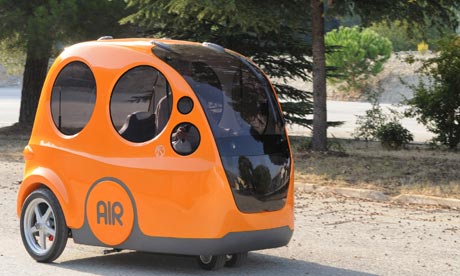
*drool drool drool*....
How would you react to someone who tried to sell you a car that runs on fresh air? Perhaps you would think he was peddling a potentially planet-saving technology. More likely you would dismiss him as a conman or a fantasist. Yet that is precisely the pitch being made by French auto engineer Guy Negre, a good-humoured man in his mid-60s who claims to have developed a car powered by compressed air: one that produces a fraction of the carbon emissions of a standard engine, reaches speeds of 30mph-plus, that can travel 65 miles on a one-minute recharge and, best of all, costs from just over £3,000.
Negre is quick to point out the drawbacks of existing eco-car technology. "Hybrids are only marginally less polluting than the most efficient combustion engines," he says. "Hydrogen power is expensive and impractical. Fuel cells are expensive and unproven and electric cars are reliant on expensive, unreliable battery technology."
Given the number of false green-auto dawns, you might wonder why air-powered cars should be any different. While Negre's air cars have similar carbon emissions to electric cars (it all depends how the electricity to power the pumps that fill their air tanks is generated), he argues that air-power is a superior technology. "Compared to electric cars, air-powered cars cost a fraction of the price to buy, they don't need expensive batteries to be replaced every five years or so and crucially they take only a fraction of the time to recharge."
Negre previously designed racing engines for Renault and has devoted the last 13 years to developing compressed air technology at his factory in Carros, outside Nice, in southern France. He believes air power has a real chance of putting a rocket up the $2tn-a-year global auto industry, radically improving the quality of urban life and making a serious dent in global carbon emissions in the process.
I confess I was so sceptical that I reserved judgment until I had driven one of his cars. On the day I visited the factory, most of the cars were at Schipol airport in Amsterdam, where from next month they are being trialled as replacements for the huge fleet of electric service vehicles operated by Air France KLM. So the version I drove was an early prototype, a three-wheeler with no bodywork, steered by a joystick.
OK, it didn't deliver the smoothly upholstered power so beloved by conventional car enthusiasts. And it possessed all the glamour of a souped-up lawnmower. But it worked, easily reaching speeds above 25mph in the limited space of the factory car park, which doubles as a test track.
In full-scale production, air-powered vehicles will range from three-wheeled buggies to a four-wheeled, five-door family saloon. Although the number of models on offer now is limited for cost reasons, they could eventually include vans, buses, taxis and boats.
The cars are made of fibreglass, which is lighter and 10 times stronger than steel, claims Negre. The compressed air is stored at high pressure in shatter-proof thermoplastic tanks surrounded by a carbon-fibre shell. (The same tanks used to contain the fuel in gas-powered buses.) The air is released through pistons in the engine, which drive the wheels. Unlike conventional internal combustion engines, air-powered engines run very cold and thick ice quickly forms on the engine. This means that the only feature that comes for free in the air car will be air-conditioning.
Each car has an onboard pump that can refill the tank overnight. But Negre has also developed a high-pressure air pump - imagine a heavy-duty version of the tyre pumps found on a garage forecourt - that can fill the tanks in less than a minute. These could be powered by clean electricity - hydro, wind or solar - making the air car completely pollution-free. Even if carbon-generated electricity is used, CO2 emissions are still only 10% of a petrol engine's, claims Negre.
That's great for urban driving where journeys are typically a few miles. For longer journeys there's a hybrid, battery-assisted version, which Negre claims can reach 100mph and travel 900 miles on one gallon of petrol.
Clearly the idea is being taken seriously by KLM. Independent energyexperts are also cautiously optimistic. "I've looked at this technology and it can work," says Ulf Bossel, a sustainable energy consultant and organiser of the European Fuel Cell Forum. "It looks good over 50km or so. I see no reason why this shouldn't be a successful form of urban transport in the near future."
But perhaps the most credible endorsement of air power comes from a £30m deal the makers recently signed with Indian car giant Tata to license the technology in Asia for use in the ultra-cheap Nano. Negre has also signed deals to manufacture the car in the US, Latin America, and several European countries, but none as yet in the UK. However, he says he is close to sealing an agreement that could see air cars on sale in the UK within three years. But if cars running on fresh air fulfil their promise, why stop there? With just a few alterations, Negre claims a hybrid version of his new engine could even be used to power aircraft.
Great research, Cin! I've always felt that catalytic converters and 'hybrid' vehicles are just a great big marketing ploy to help people feel smug and all "do-gooder" about driving. The new Honda Insight, for instance, probably has as big a carbon footrprint, if not bigger, than an average SUV. Manufacturing, transporting and disposing of automobile batteries -- that's some serious footprint there!
ReplyDeleteCompressed air cars are good for city driving, but they still have to work on safety features. We can't have light little buggies that fall apart at the slightest impact. The Tata Nano seems to me to be a string of traffic fatalities just waiting to happen! Shudder! Unless, of course, we can stop fellow drivers from being idiots. Tall order, innit?